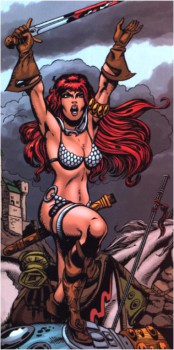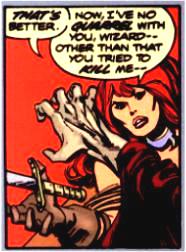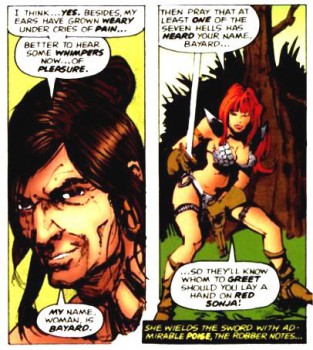In Defense of Red Sonja: The Vow
 Though interest in a modestly-dressed Red Sonja was strong in 1973, it skyrocketed in 1974 with the debut of her famous chain mail bikini in Savage Sword of Conan 1. Sonja returned in her trademark outfit later that year in Conan the Barbarian, issues 43 and 44. Titled “Tower of Blood” and “Of Flame and the Fiend!” respectively, the two-part story finds Conan and Sonja on the run from bounty hunters, sent by the sons of the king Sonja killed two stories earlier. They escape from the bounty hunters, only to find themselves trapped in a mist-enshrouded tower haunted by vampires. By this stage, I don’t understand why this sort of thing would even surprise Conan.
Though interest in a modestly-dressed Red Sonja was strong in 1973, it skyrocketed in 1974 with the debut of her famous chain mail bikini in Savage Sword of Conan 1. Sonja returned in her trademark outfit later that year in Conan the Barbarian, issues 43 and 44. Titled “Tower of Blood” and “Of Flame and the Fiend!” respectively, the two-part story finds Conan and Sonja on the run from bounty hunters, sent by the sons of the king Sonja killed two stories earlier. They escape from the bounty hunters, only to find themselves trapped in a mist-enshrouded tower haunted by vampires. By this stage, I don’t understand why this sort of thing would even surprise Conan.
Beyond the predictable motivations of the brother and sister vampires (the brother vampire lusts after Sonja, while the sister vampire lusts after Conan, and the story ends with two dead vampires), we also get further glimpses into Red Sonja’s character. When Conan suggests that her lifestyle is not a woman’s way, her response is, “You’d have me marry, I suppose, raise brats instead of hell.” (That quote should be on a t-shirt.) Further, when the vampire woman attempts to seduce Conan, he asks Sonja if she’s jealous. Her response is neither a passionate denial nor an admission: “There is no place for such womanish things in my life! Sometimes, I almost want there to be, but there is not and there never will be.” Again, her vow is something she will staunchly uphold, but it seems to be one she regrets. Which begs the question of to whom she made the vow, if not to herself.
Further, we see Sonja several times bristle over the Cimmerian helping her. She hates being in anyone’s debt. She’s not above manipulating others into helping her, but aid freely and knowingly given unnerves her. Of course, after rescuing her from bounty hunters and vampires this issue, the debt between them appears to be fairly even (if one counts the times she rescued Conan in earlier adventures). So it’s understandable that the story ends not with a friendly handshake or even a chaste kiss, but with Sonja bashing Conan on the back of the head with a rock, knocking him out so she can make her escape and not risk falling into his debt.
After that two-parter, the four Red Sonja stories published in 1975 were all solo tales. Apparently, the character had finally become popular enough to not need the additional presence of Conan. The first of these stories, “Episode,” (originally published as a back-up story in Conan the Barbarian 48) is a fairly light piece where she is attacked by a giant spider, then a wizard determined to sacrifice her to demons. The second story, “She-Devil with a Sword,” (originally in Kull and the Barbarians 2) is a strange re-interpretation of Little Red Riding Hood, albeit with more tragedy.

It’s the third story, “The Day of the Sword,” (originally in Kull and the Barbarians 3) that really brings together the finishing touches to the character, where all the pieces fit into place. Quite simply, it’s an origin story. We learn that Sonja’s father was a former mercenary, who retired to a farm after an injury cost him one of his legs. Growing up on a farm, Sonja resented that her two younger brothers were taught how to fight, while she was taught how to cook and mend. At night, she would try to teach herself how to wield a sword, but was never even strong enough to lift it.
One day, when she was a “still a girl of less than twenty years,” her father’s old mercenary squad paid him a visit and, after he refused to join up with them again, killed him in front of Sonja. After that, they murdered both her brothers as well as her mother. The leader of the mercenaries then took Sonja back into her home and raped her, leaving her for dead as he set fire to the house upon leaving. Sonja manages to escape and run into the woods, where she had a vision of a genderless divine being who promised to help her discover her inner strength. This strength would allow her not only to survive, but to make her “the equal of any man or woman (she) meets.”
And this is where the vow is explicitly stated. In “The Song of Red Sonja,” she says, “No man’s lips shall ever touch mine, Cimmerian, save those of him who has defeated me on the field of battle.” Eighteen months later, two strangers recount the legend that, “Red Sonja’s made a vow that no man ever shall touch her, save one who’s defeated her in battle.” But here we see the actual vow: “You must never allow yourself to be loved by another man unless he has defeated you in fair battle, something no man is like to do after this day.”
Now, given that the target audience for these stories was largely under eighteen, there’s only so much explicit reference that can be made about sex (even in the Comics Code-free issues of Savage Sword of Conan). So it’s entirely possible that “loved by another man” is a euphemism for sex. On the other hand, older readers would pick up on the fact that, while there’s nothing in the vow that explicitly forbids sex, a life without love is a far lonelier one than a life without sex. Since her entire family is dead, it could be argued that at the time the vow was made, there was no one living who loved Sonja. And the pain she was feeling would make the prospect of never being loved again almost a comfort, since it meant she would never again risk losing those who loved her.
Many readers take the vow to be a rape challenge, that Sonja will only have sex if she is taken by force. But if we take the vow in its literal sense, then it adds far more depth to the character than simply being fodder for rape fantasies.
Why would she refuse to love a man who couldn’t defeat her in combat? What would be the purpose of basing love on physical prowess? Consider that she watched her father, mother, and two younger brothers all murdered by trained mercenaries. They were unable to defend themselves and thus they died. In that light, it would make sense that she reserve her heart only for those individuals who prove their ability to survive.

Of course, given her lifestyle, Red Sonja makes many enemies and this vow becomes an even greater necessity, as it is likely that anyone who loves her will be a target for those enemies. And here we see another explanation for her reluctance to have Conan follow her for too long. She sees a man who routinely places his life in danger to help his friends and knows that he will do (and, in fact, has already done) the same for her. From this point of view, it makes sense that she would escape from him. Taking her first nine stories together, Red Sonja is a woman who finds herself free to wander across the whole world, while at the same time having no place in it to truly call home.
Or she’s just a redhead in a chain mail bikini. Take your pick.
As for the fourth Red Sonja story published in 1975? Marvel published a new title called Marvel Feature, which would work as a sort of try-out book, testing reader response before deciding whether or not to award the character a series of his or her own. It premiered in November 1975 with Red Sonja, who would appear in the first seven issues before being promoted into a book all her own. She’d go through two more self-titled books, a series of paperback novels, and a film before Marvel finally gave up the rights to her in the 1990s. Eventually, the rights would be picked up by another comic publisher, Dynamite Entertainment, that would start a new line of titles that continue to be published to this day.
To this day whenever I think of Red Sonja I can’t help but picture Wendy Pini. Pini, of Elfquest fame, along with artist Frank Throne had a Red Sonja show that went from convention to convention back in the late 70’s. Thorne played a wizard and Pini, complete with a custom made metal bikini, played a surprisingly ferocious Red Sonya. Ahh the good old days.
I like your take on the vow. Everything about the character makes more sense shaped around the vow as you describe it.
[…] In Defense of Red Sonja: The Vow […]